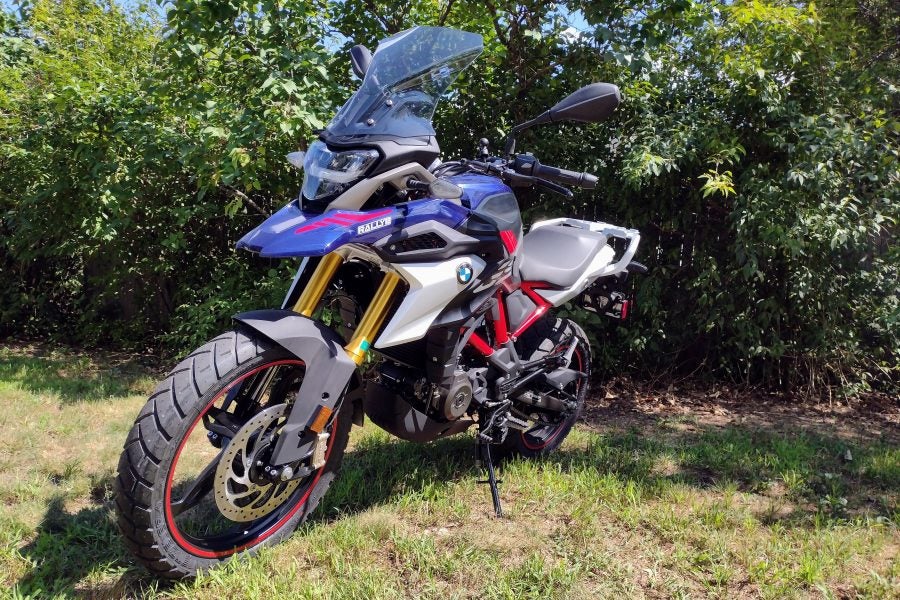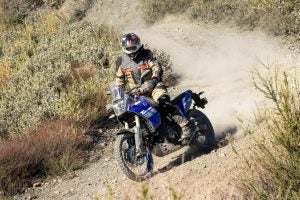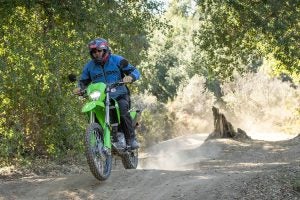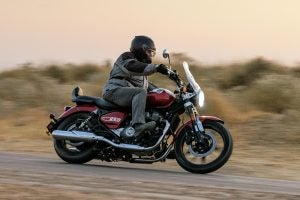The BMW GS series is probably the most iconic of modern adventure motorcycles. Ewan and Charley brought them into the social consciousness, so now BMW enjoys a seat at the table of the general populace’s knowledge of motorcycles alongside Harleys (every cruiser) and Ninjas (every sport bike).
BMW makes the GS in a bunch of different flavors, these days. Even if you don’t plan to take your motorcycle off road, the comfortable Adventure style seating position makes it a popular everyday machine.
Why a 310 GS?
When BMW decided to release a tiny version of its GS, it caught my interest. And recently when I decided that what I needed in my life was a lightweight dirt-capable street bike (as opposed to a street-legal dirt bike), the baby GS had my full attention. I don’t ride hard-core enough to need spokes, and that means no tubes in my tires either. Bonus!
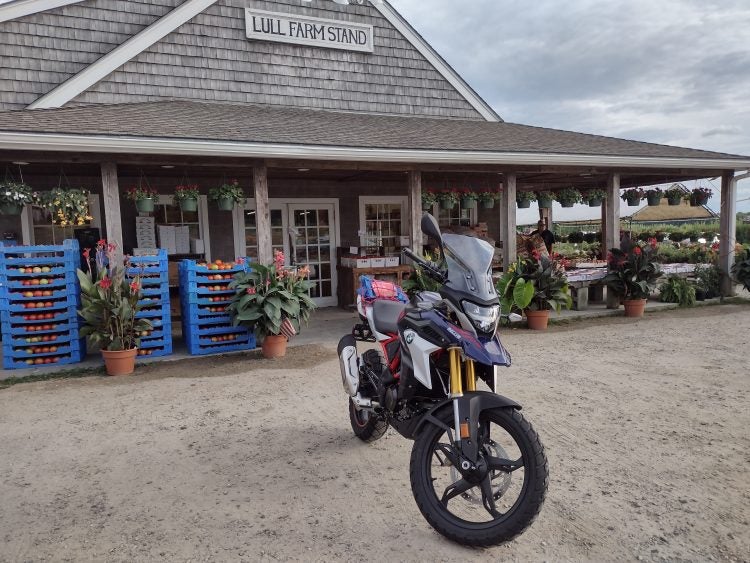
So new it doesn’t have any luggage yet! Photo: Kate Murphy
Background
Note that I am coming from a decade of KLR ownership. I loved that KLR, but found it was too heavy for the dirt riding I like to do. A friend of mine sold me his marvelous little WR250X, which was very lightweight and nimble. That bike turned out to be too much of a dirtbike for the road-riding I wanted to do, to get to the dirt roads and events. I already own a Super Ténéré for heavy long-distance touring, and a 3rd-gen SV650 for day trips and track use.
Enter the 310 GS. It’s light enough to be very easy to ride on dirt, push around the garage, load up on a trailer when necessary. But it has a pretty stiff stock suspension and a factory rear rack, making it much more capable when it comes to my favorite activity: motorcycle camping.
What’s It Like?
The G 310 GS is basically a more civilized, smoother, lightweight, fuel-injected KLR with ABS (yes, I know the 2022 KLR solved a lot of these problems… except the weight). The 310 has about the same or just a couple fewer hp vs. the KLR, depending on the mods the KLR has had. Stock, they both put out nearly the same (34hp vs. 35). You feel it, though, in the low-end grunt: the KLR puts out 39ft/lb and the 310 only 20. That just means shifting happens a little more often, to keep that small engine in its power band.
Trouble In Paradise
The first few miles on this brand new machine promised slow-bike-fast style goofy fun, but little did I know, all was not well. More on that after the first-on upgrades.
The Upgrades
We all know a new bike is just a starting point, and when the work begins. I’ve already begun the upgrade on this babyADV; the first thing I installed was a set of tank pads, for grip and to keep my jacket from scratching the tank. I’ve bolted on some wind protection. I’m on the hunt for crash bars, and the future will include a bash plate, knobbier tires, luggage, a tank bag, a beefy horn, an aux light setup, and possibly suspension work.
The Sketchiest Aftermarket Ever
I note here that the 310 series is very, very popular in Southeast Asia and South America. It is not so popular in the “bigger-is-better” United States, where I am. That means limited aftermarket and upgrade parts availability except on sites like Amazon and AliExpress. I’m going to be testing out a bunch of really sketchy and questionable accessories and telling you all about them! Let’s begin!
Tank Pads
I was already starting to see scuffs in the paint where my jacket zipper makes occasional contact, so tank pads hit the top of the “needs” list. These are “NightCat” from Amazon. They were just shy of $30 USD, and for the price I was surprised by the quality. They feel like heavyweight rubber, and they’re nice and grippy on the tank sides. The center pad protects the tank from my jacket zipper quite nicely.
Installation was as easy as any other stick-on accessory. Lining everything up was the hard part, but once they’re tacked on and centered, it’s just a question of peeling off the backing, letting the stretchy rubber pad recover, and then anchoring with its own adhesive.

Line it up, tape it down, then peel off the backing. Photo: Kate Murphy
A few reviews say the material breaks down and gets a bit sticky after a while. I’m going to keep an eye on that, because for the price, if I have to peel them off and replace them every few years I’m not mad. Some time and slow work with some Gorilla Tape will take all the sticky right off.

It even advertises the model name. Photo: Kate Murphy
Wind Protection
This is another Amazon find, from the brand “Lorababer.” It cost me thirty (30) dollars US, and for that price, I figured the risk was definitely worth it. It arrived in a beat-up box, but the windshield was well packed and sound. The fitment is… not perfect, but after flattening out its curvature I was able to get the bolt holes lined up.
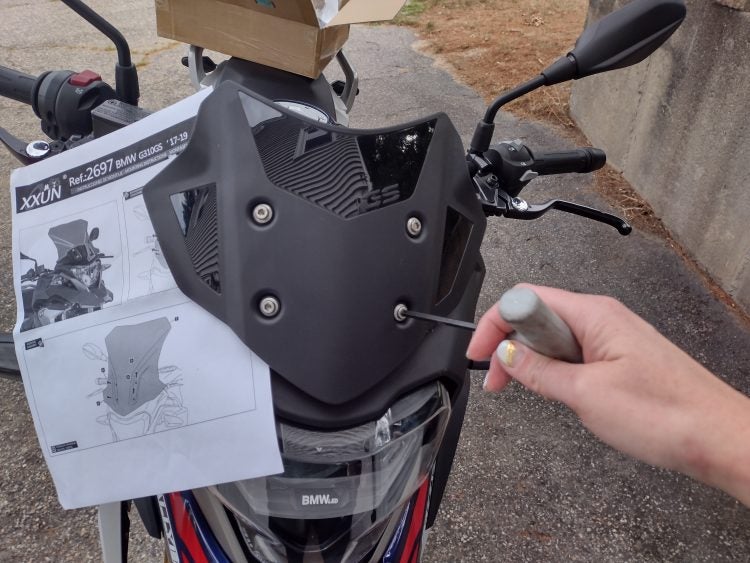
Pulling the stock “windshield” off was very straightforward. Four bolts. Photo: Kate Murphy
I used the grommets and spacer-washers from the stock windshield on the new one, to get the bolts tight without over-torquing and cracking the plastic.

New cheap-o windshield is quite sturdy! Photo: Kate Murphy
To my great surprise the windshield is fantastic. The construction is as beefy as any name-brand shield I’ve worked with (MRA, Puig, National Cycle) and the wind protection works great.
The Breakdown
Here’s the bad news. One hundred and eighty miles into my ownership of the bike, halfway to its first real destination: Vermont’s Mount Ascutney, the bike started to give me fits. The engine was stuttering and hesitating under load, and I couldn’t top 40mph up any kind of hill. The check-engine light had come on and the “caution” triangle lit up yellow. I pulled over in Henniker, NH, an hour from home, to check the bike’s battery connections and make sure nothing looked wrong.
I called the dealership that sold me the bike, and the service guys there had never heard of one of these, new, having this kind of trouble. They recommended a “capacitor discharge.” This means I pop the seat off, disconnect the main battery leads, touch them together, and reconnect them to the battery. That didn’t help. I added fresh gas. That didn’t help either. There wasn’t much else to be done out there but try to get it home.
I Made It, But It Wasn’t Fun
On my way home, the bike’s performance and power delivery went from a stuttering hesitation to full-on bogging on any application of throttle at any RPM. My top speed decreased to 20mph, and then the bike stalled. It seemed that pulling over to let the bike cool off (engine temp was running between 178-182 degrees Fahrenheit) helped, and so I leap-frogged it like that all the way home: start the bike, get what power I could, roll, ride ’til it stalled, pull over and wait, repeat. All that while also waving traffic around me and trying not to get run over.
So now the dealership is scheduled to pick the bike up and figure out what’s wrong. A sensor that was bad from the factory? A bad fuel sender? Problems with the fuel injection? Hit me with your bets in the comments.
Once I get the bike back, fixed, what other upgrades should I consider? Let me know what you’re enjoying on your bike in the comments, too!


